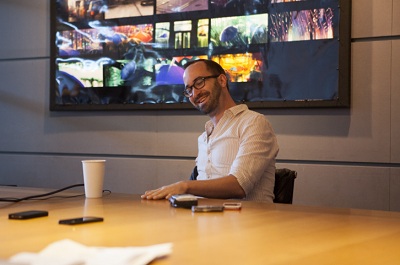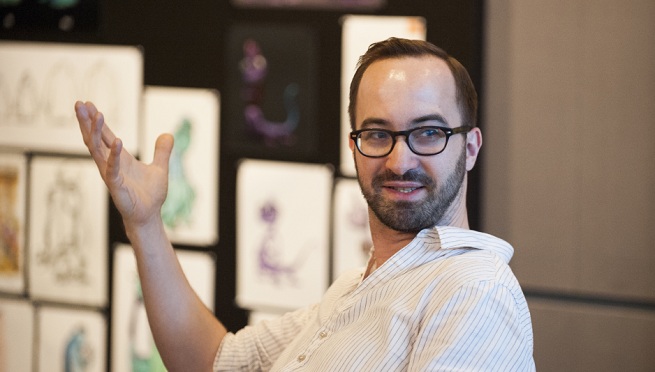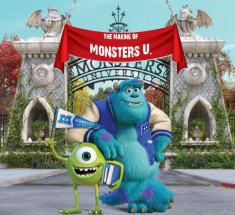Director Saschka Unseld gets a good laugh when people learn that his film, The Blue Umbrella, is entirely animated. The short, which debuts alongside Pixar’s feature film Monsters University this summer, looks so real that you would swear it’s a blend of live action and animation. But it’s not, and that’s part of its beauty.
 The plot of the six-minute film is simple. A blue umbrella meets a red umbrella on the street, by chance. The blue umbrella tries to get back to the red umbrella, but it gets blown around and weather-beaten during a rainstorm. While the weather conspires against the umbrellas, objects on the street work to bring the umbrellas together.
The plot of the six-minute film is simple. A blue umbrella meets a red umbrella on the street, by chance. The blue umbrella tries to get back to the red umbrella, but it gets blown around and weather-beaten during a rainstorm. While the weather conspires against the umbrellas, objects on the street work to bring the umbrellas together.
It’s cute movie, but it’s startling to learn that technology can fool the eye. When a “walk” sign on a street signal smiles, it looks like a video that has been modified with special effects to smile. But the scene is entirely built from an animation created on an artist’s computer. It has photorealistic shading, lighting, and compositing. The film benefits from Pixar’s new “global illumination” technology that mathematically models each beam of light in every scene. That means the animated rain looks like real rain — and everything else that’s animated looks real as well.
Unseld met with a group of journalists at Pixar’s headquarters recently. Here’s an edited transcript of the conversation.
Behind the tech magic: Monsters University
VentureBeat: When I saw the film, I thought everything in it was real. Now we find out that it is animated. How did you make an animation look so real?
Saschka Unseld: The thing that took me a while to get used to is that as the director, I don’t do any hands-on work. I always feel humbled by the team, that they were able to do this while I just asked them to do it. Initially, we were thinking about shooting some parts of it. During my film studies, I shot live-action films and did some commercials. If you were to start to go down that route in your head, though, of shutting down a downtown city block and filling it with dozens of cars and extras and people with umbrellas and making it rain there, and being able to control that, you don’t want to do it. Even if you were to shoot a commercial where it is live action, you’d use CG.
VentureBeat: Did you work on any films before this at the Filmakademie film school that we should all know about?
Unseld: I worked on a couple of them. I never directed one of the famous ones, but I worked on a couple of them. If you remember Rocks, [it] was nominated for an Academy Award in 1990-whatever. It had two stone creatures and time passes faster for them. That was ages ago. Then I did a couple other ones. Annie and Boo, that Johannes Weiland directed. Those were all good friends of mine from my time at the Filmakademie.
Unseld: Yeah, The Gruffalo. I worked on that with Jakob Schuh, who ended up co-directing with Max Lang. I directed the pitch for that before I came here. That was when I left the studio and started at Pixar.
VentureBeat: When you thought about The Blue Umbrella, did you think about doing it with photorealistic backgrounds from the beginning?
Unseld: Not really. It’s funny. It was during yesterday and today that I realized I actually never thought of it being photorealistic initially. The idea just came from the umbrella I found. For a long time I worked on coming up with an idea or a story for an umbrella. The first idea was that somebody had thrown the umbrella away and the umbrella tries to get back to his owner. Like when someone breaks up with you and you want to be with that person, that person who just threw you away. But I could never come up with a happy ending to that story.
I worked on it for a long while like this, which of course has nothing to do with whether it’s photorealistic or not. It was half a year later that I started to think of the short more as being about the rain, being a declaration of love for the rain. Where I grew up, it rains much more than here. I like the rain a lot. I love cities in the rain. The rain turns the city into a magical place. That’s when the idea of city characters coming to life mixed in with it. It’s not just the umbrellas coming to life when it rains, but the whole city comes to life. That was part of a coincidence of me exploring what story I wanted to tell.
It wasn’t until I actually pitched the story here [at Pixar] — the story was kind of in the shape that it is in the final film when I pitched it, but I pitched it just verbally with maybe four pictures to underscore certain story beats. Then, after I pitched it, I showed a test I had done, which was unrelated at the time. I had an idea for a music video where a city sings a song. On my phone I had filmed a couple of faces I’d seen around my block. I loaded them on my computer and animated them to a song. In the pitch, after I told the story, I said, “By the way, when I said the city comes to life, I have this test I want to show you.” Just to make people understand the idea of it and what I mean about it.
I watched people watching this, and this moment of the first blink — I had exactly the same character as ended up in the final film being the first character who comes to life in the test. Just someone a block away from where I live. There was this magic to the perception, in the first five seconds, being, “It’s real … no, what’s going on there?” Then there’s this slow descent into, “Oh, this is alive.” That worked because it was photorealistic. So it was during that pitch process that I realized there is something unique about this thing. We all started thinking, “What if we do the whole thing photorealistic?” It had nothing to do with the original story idea. It came during the process.

VentureBeat: Obviously, your music is a very important part of this. Who did the music?
Unseld: It was a kind of collaboration. In that test I talked about earlier, the one I did on my iPhone where I thought it would be a music video, it was a song from Sarah Jaffe, who’s the vocalist in the final piece. Her voice had been with me since the very beginning, even before I had the story. She’s a brilliant singer and songwriter from Texas. I don’t know why she’s so unknown.
Singer-songwriters do a bit of a different thing from composers, because the song is three or four minutes long. It has one mood and one idea. A score needs to change mood and rhythm on a dime. We wanted a composer composing the music, but her as the vocalist. That ended up being Jon Brion , who I love for the stuff he did on Punch-Drunk Love or Eternal Sunshine of the Spotless Mind. He sets such a light tone, but [has] such catchy melodies. So he scored the whole thing and Sarah Jaffe is the vocalist. For me, it’s almost a karma thing. Her voice inspired the idea of making a music video with city faces, because I was walking around listening to her in the city. Having her as the final voice in the film, there’s a simplicity to it that I really like.
 VentureBeat: You mentioned earlier that it was hard to do the human faces, and so you avoided that. What was the easier part as far as making it look real? What were some of the things you did to make things look more real?
VentureBeat: You mentioned earlier that it was hard to do the human faces, and so you avoided that. What was the easier part as far as making it look real? What were some of the things you did to make things look more real?
Unseld: Initially, everyone thought the first shot should be easy, but then it ended up not being that easy, because you can see everything in broad daylight. We had a lot of things working in our favor to make it look real. First, the fact that it’s night helps a lot. So much stuff is in darkness. The rain helps a lot, because it adds a certain amount of complexity and detail. If it weren’t raining, we wouldn’t get that, and you would look more at other things, because of the buildings. Something I was interested in was using a very shallow depth of field. For me, there’s a beauty in it. That blows out the whole background, so you don’t have to build the city out to infinity. So several things worked in our favor. Without those, we wouldn’t have been able to do it.
The depth of field stuff, though, we didn’t add it simply because it was easier that way. It was something I wanted to explore. The reality is there in the beginning, where everything is evenly lit in the daylight, and it stays photorealistic throughout, but there are so many elements of filmmaking that you can use to make something very expressionistic and very lyrical. Even though it’s photorealistic, I wanted it to be more artistic and more bold than animated movies usually are. Out-of-focus backgrounds do that. They’re nearly painterly — a red splotch, a blue splotch, something like that. The same thing happens with the neon lights. It’s so boldly lit. Some shots are just green or red or blue. These kinds of things, I found, were important to make that place magical, even though it’s real.



